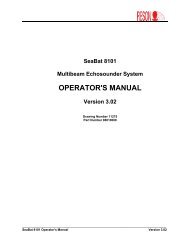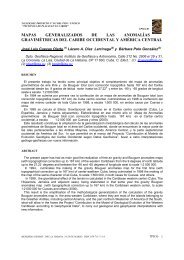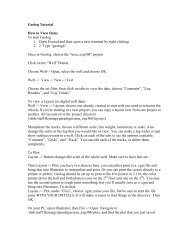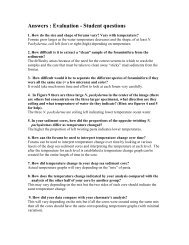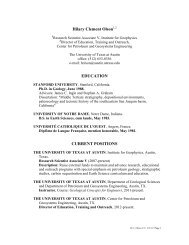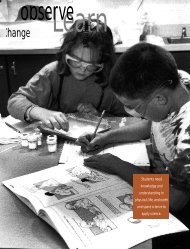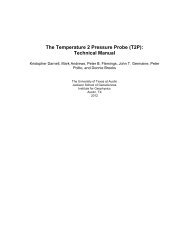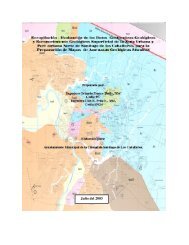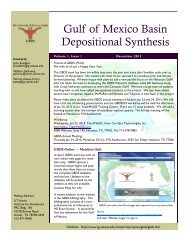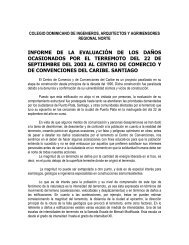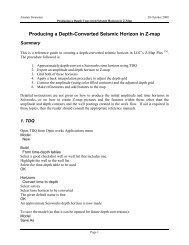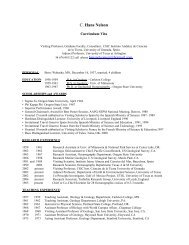IGCP Project short title: Caribbean Plate Tectonics Duration and ...
IGCP Project short title: Caribbean Plate Tectonics Duration and ...
IGCP Project short title: Caribbean Plate Tectonics Duration and ...
Create successful ePaper yourself
Turn your PDF publications into a flip-book with our unique Google optimized e-Paper software.
18<br />
of the Guaniguanico terrane, suggests that some Guaniguanico elements (or nonmetamorphosed<br />
Escambray units) were located off Belize at least in the Lower Cretaceous<br />
(see also Hutson et al., 1999).<br />
The Pindell <strong>and</strong> Kennan <strong>Caribbean</strong> plate tectonic model. J.Pindell<strong>and</strong>L.Kennan<br />
presented a new unpublished version of the Pacific origin of the <strong>Caribbean</strong> plate style of<br />
model, as two distinct papers. This model was also a subject of discussion during the first<br />
<strong>IGCP</strong>-433 meeting in Río de Janeiro. Many new important issues are reviewed in this new<br />
version, so it is much more comprehensive than previous ones, but several critical moments<br />
of the model are going to be debated in future meetings.<br />
WORKSHOP ON THE NORTHERN CARIBBEAN PLATE BOUNDARY, 4TH CUBAN<br />
GEOLOGICAL AND MINING CONGRESS<br />
Havana, March 22-27, 2001<br />
Conveners: E. Lidiak <strong>and</strong> M. Iturralde-Vinent<br />
A symposium <strong>and</strong> field workshop on the Northern <strong>Caribbean</strong> Boundary was held in<br />
Havana, Cuba, as part of the 4th Cuban Geological <strong>and</strong> Mining Congress (March 19-27,<br />
2001). The symposium, which included both oral <strong>and</strong> poster sessions <strong>and</strong> which was held on<br />
March 22, focused mainly on issues concerning the complex northern margin of the<br />
<strong>Caribbean</strong> plate in Cuba <strong>and</strong> its early geologic evolution. Among participants where<br />
scientists from Argentina, Canada, Chile, Colombia, Cuba, France, Great Britain, Italy,<br />
Mexico, New Zeal<strong>and</strong>, Spain, <strong>and</strong> USA.<br />
A field trip to Central Cuba was held immediately after the Congress, March 24 to<br />
27, in order to visit critical areas in the vicinity of Camagüey, central Cuba, where the<br />
northern <strong>Caribbean</strong> plate boundary is well exposed. This complex boundary near Camagüey<br />
encompasses elements of the passive continental margin, ocean crust <strong>and</strong> sediments,<br />
Cretaceous volcanic arc, as well as forel<strong>and</strong> <strong>and</strong> piggyback basins. The field excursion<br />
provided the participants with an excellent opportunity to examine in the field the structures<br />
<strong>and</strong> geologic relationships associated with this unique <strong>and</strong> critical tectonic boundary.<br />
The purpose of the symposium was to focus on the characteristics of critical<br />
geologic terranes in central <strong>and</strong> eastern Cuba, Hispaniola, <strong>and</strong> Puerto Rico as they pertain to<br />
the northern <strong>Caribbean</strong> plate boundary in Cuba <strong>and</strong> to evaluate the present status of<br />
<strong>Caribbean</strong> plate tectonic models with respect to these field occurrences. Six special oral<br />
papers <strong>and</strong> 5 posters were presented. Each speaker was given 30 minutes, so extensive<br />
discussion followed each talk. These presentations were followed by a panel discussion<br />
period of several hours duration in which aspects of the northern plate boundary <strong>and</strong> the<br />
18



